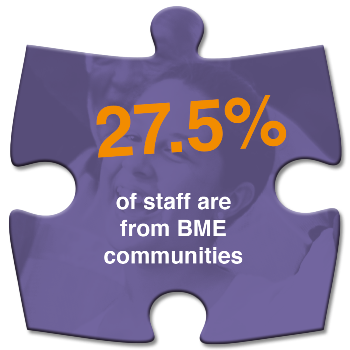News and views
Go back

Reflecting the diverse communities we work in through BAME staff development
Looking back 18 months, I think I can admit to being a bit smug. We have always made local recruitment part of what we do. Reflecting the diverse communities we work in was our mantra. We didn’t need the research to tell us that diverse teams were better performing – we already knew this. We were also committed to it because it fitted with our social justice mission – giving opportunities to people with the least.
For years we monitored the diversity of our staff and consistently had around 30% of staff identifying as BAME. It was something I was very proud of. Then our Executive team (75% female, 25% BAME and 25% gay) looked at our new succession plan. Our wider Leadership Team also reflected our strong commitment to diversity (36% BAME and 64% female). But when we looked at the senior managers who we might want to grow into Leadership roles – it was a shock to realise how white they were.
What had gone wrong and how could we not notice? We had become complacent. We didn’t think we needed to do anything, because we are a good organisation with values driven staff who are committed to what we do. We were already good at diversity. We had ticked that box. But now I realise that we had taken our eye off the ball. While we’d been smugly assuming we had it sorted, the endemic inequalities in our society were doing their worst.
The statistics tell the story…
Despite being a female-led organisation, we still have a gender pay gap of 10.6%. At least we know why that is. We employ a lot of nursery staff – a role which is traditionally filled by women, which is low paid. While we do all we can to improve terms and conditions for our staff, we are constrained by what commissioners and parents will pay for this service. But then we did the BAME pay gap analysis and it is a startling 10.3%. There is no easy rationale for this. BAME staff in our organisation earn less and are less represented in senior, well-paying roles.
Not my proudest moment. But I can honestly say that I am proud of our response. We are not hiding this problem. We are taking it on. In true enterprising style we set about fixing ourselves. We reviewed everything and developed an action plan:
Recruitment
We introduced a new online recruitment process to better track the diversity of applicants, shortlisted candidates and successful candidates, enabling us to identify potential biases and barriers. We introduced new training for managers to raise awareness and have reiterated the need for all interview panels to have a diverse membership. We have changed the recruitment policy to reflect our view that the best candidate is the one that meets the job requirements and the workforce needs – not necessarily the candidate with the most qualifications and experience.
Staff development
We introduced coaching training for all our managers. We held a staff development day for all our BAME staff who want to develop their careers. Each one has a Leadership Team mentor who has reviewed their personal development plan with them and their manager, and has had a session with an external coach (kindly donated by Cascade).
Workforce plans
These are now required to specifically look at diversity of teams and identify actions to improve where they fall short.
BAME graduate trainees
We have recruited three graduate trainees on a two-year programme, to develop their skills and hopefully move them into management positions within the organisation.
We haven’t seen the results of this work yet, so watch this space. What you can be sure about is that we will be! Bad as it is, it was a timely lesson that we can’t afford to be complacent about tackling inequality – even in a ‘right-on’ organisation like ours.
